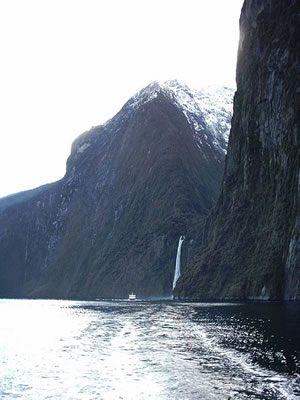Milford Sound is the most northerly of about a dozen fjords in the southwestern corner of the South Island of New Zealand.
Its majestic cliffs, dense forests and sparking waters caused Rudyard Kipling to call Milford Sound "the eighth wonder of the world".
The valley of Milford Sound was created by enormous glaciers from the mountains 20,000 years ago.
 10,000 years later, when the glaciers retreated, the waters of the Tasman Sea rushed in to create a fjord 19km (12mi) long and 2.5km (1.5mi) at its widest. Meanwhile, the world's highest sea cliffs rose up almost 1.6km (1mi) from the water's edge and descended beneath the water to depths of 396m (1,300ft).
10,000 years later, when the glaciers retreated, the waters of the Tasman Sea rushed in to create a fjord 19km (12mi) long and 2.5km (1.5mi) at its widest. Meanwhile, the world's highest sea cliffs rose up almost 1.6km (1mi) from the water's edge and descended beneath the water to depths of 396m (1,300ft).
The retreat of smaller, tributary glaciers created "hanging valleys", in which streams spill their waters into Milford Sound as waterfalls with drops of more than 300m (1,000ft).
Mitre Peak stands at the entrance to the fjord. The peak rises, in an almost-perfect pyramid, to 1,695m (5,560ft) above the sea. Its slopes, and those of other mountains surround¬ing the fjord, are blanketed with thick forests, mostly of beech trees.
These woodlands are protected by Fiordland National Park.
The Water
The water in Milford Sound has an unusual composition.
The fjord's mouth is narrow and shallow, restricting the inward and outward flow of seawater. This is because the glacier lost its power before reaching the sea, leaving intact the rock walls at the seaward end of the valley. It also left a ridge, or sill, of rock across the entrance, which means that the water here is only 55m (180ft) deep.
In addition, the region experiences a great deal of rainfall. The average annual precipitation at Milford Sound is 6.43m (21.5ft). This enormous volume of water is deposited over the surround¬ing mountains and percolates through the deep beds of moss and humus-rich soils that carpet the forested slopes.
By the time the water reaches the fjord, via myriad mountain waterfalls and streams, it is stained the color of tea by the organic materials it has collected. When this rainwater arrives at the fjord it does not mix with the saltwater but, being less dense, forms a layer 3m (10ft) thick on top.
This freshwater film gradually moves seaward, dragging with it the upper layers of saltwater. This movement creates a counter-current and draws seawater into the fjord to a depth of 30m (100ft). Because of this superficial exchange of seawater and freshwater, much of Milford Sound's deep water has become almost deoxygenated and stagnant.
Life in Milford Sound
Milford Sound is home to many unique forms of wildlife.
Within the woods of Fjordlands National Park lives the takehe, a rare, flightless blue and purple bird that is about the size of a chicken. It was believed that the takehe was extinct until a colony of about 100 birds was discovered in 1948.
Another rare bird that can be found in the national park is the kakapo, a parrot that resembles an owl and lives in a burrow.
Marine Life
The layer of freshwater on top of Milford Sound has had a profound effect on its marine life.
The tidal waters are free of the algae and mollusks commonly found on the coasts of New Zealand because these creatures cannot tolerate the low levels of salinity. The fjord's intertidal zone is colonized, instead by species of snail, green sea lettuce, blue mussels and barnacles, all of which are normally associated with brackish waters.
The plant and animals that do survive here are those normally associated with deeper seawater.
This is because the dark color of the top layer of freshwater makes it difficult for sunlight to penetrate. This encourages species from deeper waters, such as brachiopods, sea squirts, sea pens, sea feathers and gorgonians, to occupy niches higher up among the ledges and fissures of the steep, rocky walls.